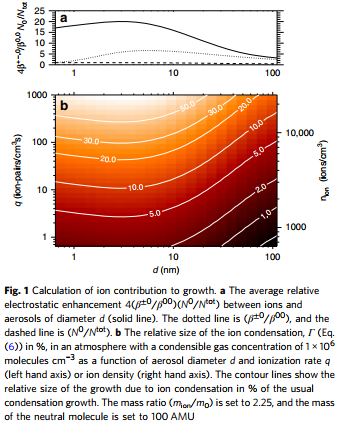A new study shows how atmospheric ions, produced by the energetic cosmic rays raining down through the atmosphere,help the growth and formation of cloud condensation nuclei – the seeds necessary for forming clouds in the atmosphere. When the ionization in the atmosphere changes, the number of cloud condensation nuclei changes affecting the properties of clouds.
More cloud condensation nuclei mean more clouds and a colder climate, and vice-versa.
Since clouds impact the amount of solar energy reaching the surface of Earth the implications can be significant for our understanding of why climate has varied in the past...and also how to make more accurate estimates of what the future might bring.
Cloud condensation nuclei can be formed by the growth of small molecular clusters called aerosols. A key assumption, since no mechanism was known to achieve this, has been that additional small aerosols would not grow and become cloud condensation nuclei. The newresults in Nature Communications change that and experimentally and theoretically detail how interactions between ions and aerosols can accelerate the growth by adding material to the small aerosols and thereby help them survive to become cloud condensation nuclei.

This supports other empirical evidence regarding how solar activity plays a role in variations in Earth’s climate, such as the Medieval Warm Period around year ~1000 AD and the cold period in the Little Ice Age 1300-1900 AD, which both match changes in Solar activity.
In short, the paper asserts:
• Cosmic rays, high-energy particles raining down from exploded stars, knock electrons out of air molecules. This produces ions, that is, positive and negative
molecules in the atmosphere.
• The ions help aerosols - clusters of mainly sulphuric acid and water molecules - to form and become stable against evaporation. This process is called nucleation. The small aerosols need to grow nearly a million times in mass in order to have an
effect on clouds.
• The second role of ions is that they accelerate the growth of the small aerosols into cloud condensation nuclei – seeds on which liquid water droplets form to make clouds. The more ions the more aerosols become cloud condensation nuclei. It is
this second property of ions which is the new result.
• Low clouds made with liquid water droplets cool the Earth’s surface.
• Variations in the Sun’s magnetic activity alter the influx of cosmic rays to the Earth.
• When the Sun is lazy, magnetically speaking, there are more cosmic rays and more
low clouds, and the world is cooler.
• When the Sun is active fewer cosmic rays reach the Earth and, with fewer low clouds, the world warms up.
“Finally we have the last piece of the puzzle explaining how particles from space affect climate on Earth. It gives an understanding of how changes caused by Solar activity or by super nova activity can change climate.” says Henrik Svensmark, from DTU Space at the Technical University of Denmark, lead author of the study.






Comments